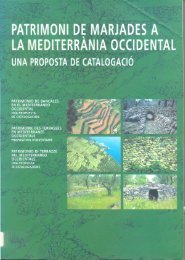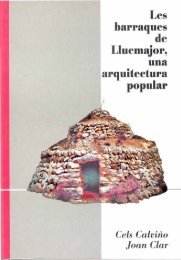La pedra en sec. Materials, eines i tècniques tradicionals a les illes ...
La pedra en sec. Materials, eines i tècniques tradicionals a les illes ...
La pedra en sec. Materials, eines i tècniques tradicionals a les illes ...
Create successful ePaper yourself
Turn your PDF publications into a flip-book with our unique Google optimized e-Paper software.
** *<br />
* *: 6 6.3 DRYSTONE MASONRY STRUCTURES<br />
190<br />
WATER USE<br />
MANAGEMENT<br />
The lack of rainfall and high temperatures<br />
in summer, characteristic of<br />
the island's Mediterranean climate,<br />
made it necessary to build ing<strong>en</strong>ious<br />
drystone masonry structures to store<br />
rainwater or surface runoff, and also<br />
to collect underground water produced<br />
by the infiltration of the limestone<br />
and quaternary deposits which make<br />
up a large part of Majorca.<br />
In terms of water extraction, wells<br />
and waterwheels are frequ<strong>en</strong>tly found<br />
on the coastal plains or in the bottoms<br />
of valleys where the water table layer<br />
is not so deep down. In the mountainous<br />
areas, especially in the Serra de<br />
Tramuntana, natural springs and other<br />
sources where permeable and impermeable<br />
rock meet were tak<strong>en</strong> advantage<br />
of and adapted, the water being<br />
collected and drawn to the surface by<br />
gravity along drystone galleries<br />
(mines or underground passages).<br />
From a strictly building point of<br />
view, the simp<strong>les</strong>t and most common<br />
types of wells are circular walled<br />
ho<strong>les</strong> with their <strong>en</strong>trances at ground<br />
level.<br />
To stop people falling in they were<br />
covered with branches or surrounded<br />
by a pareto or low wall (call or neck).<br />
Less frequ<strong>en</strong>tly they are elliptical or<br />
square-shaped. The most elaborate<br />
ones have a capelleta (small dome) to<br />
protect the water and to prev<strong>en</strong>t evaporation<br />
or are built into a terrace wall.<br />
Water is extracted manually using a<br />
bucket tied to a rope or with the help<br />
of a wood<strong>en</strong> or iron pulley.<br />
Waterwheels are wells that are normally<br />
rectangular with rounded corners<br />
and a system of gears to withdraw<br />
the water which was traditionally<br />
worked by animal power. These constructions,<br />
found in places where the<br />
water table is not very deep, oft<strong>en</strong><br />
have drystone masonry ho<strong>les</strong>, necks<br />
and bases or mounds and may also<br />
have an underground passage for<br />
access into the well.<br />
Natural springs found at the foot of a<br />
terrace wall were oft<strong>en</strong> adapted using<br />
drystone masonry capelletes and<br />
more complex systems were used for<br />
underground passage springs, which<br />
consisted of digging out underground<br />
galleries down to the water table to<br />
withdraw water.<br />
Underground passage springs<br />
usually have drystone masonry faced<br />
<strong>en</strong>trances, passages and op<strong>en</strong>ings.<br />
The features of the place where<br />
water is extracted together and the<br />
use that is made of it determined the<br />
setting up of a water supply system<br />
involving irrigation channels, cisterns<br />
and small reservoirs.<br />
Likewise the range of uses (crops,<br />
livestock, manufacturing, human consumption)<br />
and the fact that water is a<br />
scarce resource have, throughout the<br />
island's history, led to the creation of<br />
public exploitation systems for<br />
springs and wells by groups of users.<br />
In the municipalities in which the pres<strong>en</strong>ce<br />
of water resources has made it<br />
possible to establish complex<br />
systems for using springs (Banyalbufar,<br />
Soller, Alaro, etc.) , irrigation farmer<br />
associations or unions were founded<br />
to control the irrigation rights of each<br />
farmer, to lay down regulations for the<br />
cleaning of irrigation channels, to<br />
impose sanctions on off<strong>en</strong>ders, etc.<br />
Reservoirs that were partly or completely<br />
built of drystone masonry were<br />
used to collect rainwater or surface<br />
runoff. Cisterns were oft<strong>en</strong> built in<br />
houses that collected water from the<br />
roof; to prev<strong>en</strong>t leakage the hole itself<br />
was not a dry stone structure but its<br />
call and capelleta quite oft<strong>en</strong> were.<br />
Some cisterns were built into terrace<br />
walls to collect the water that flowed<br />
into them.




